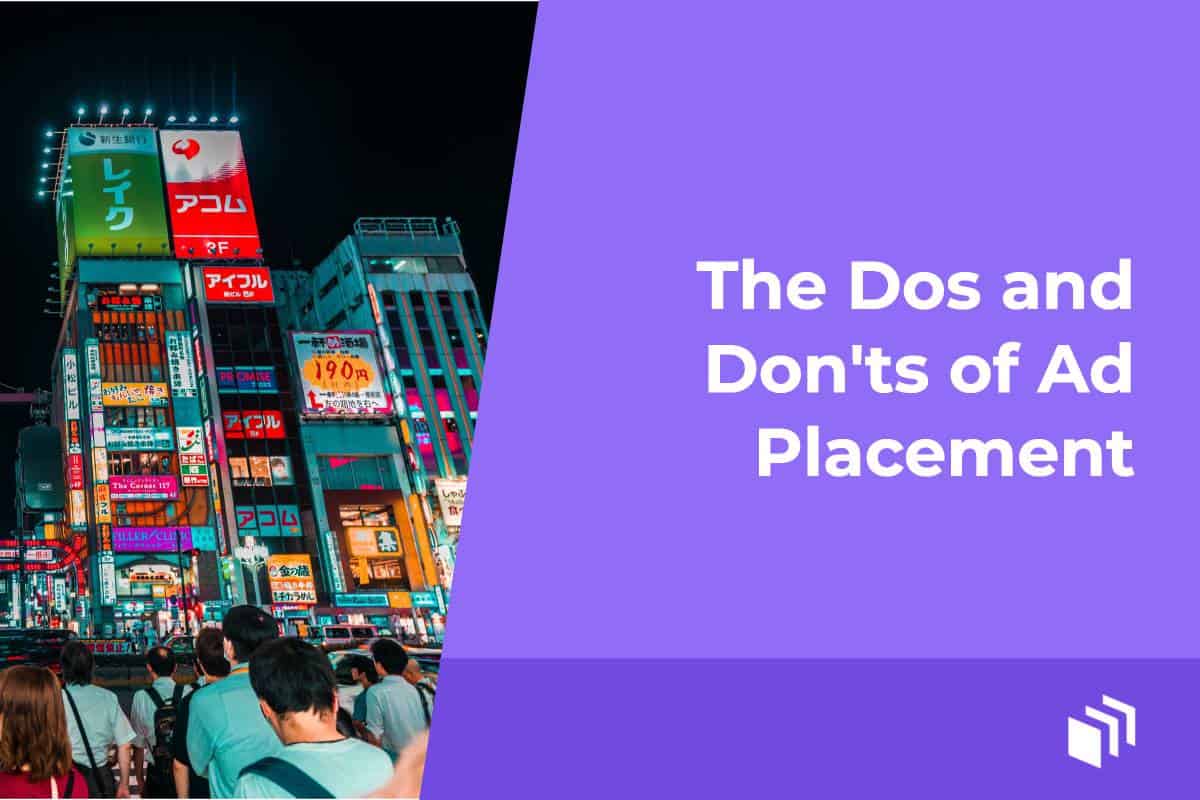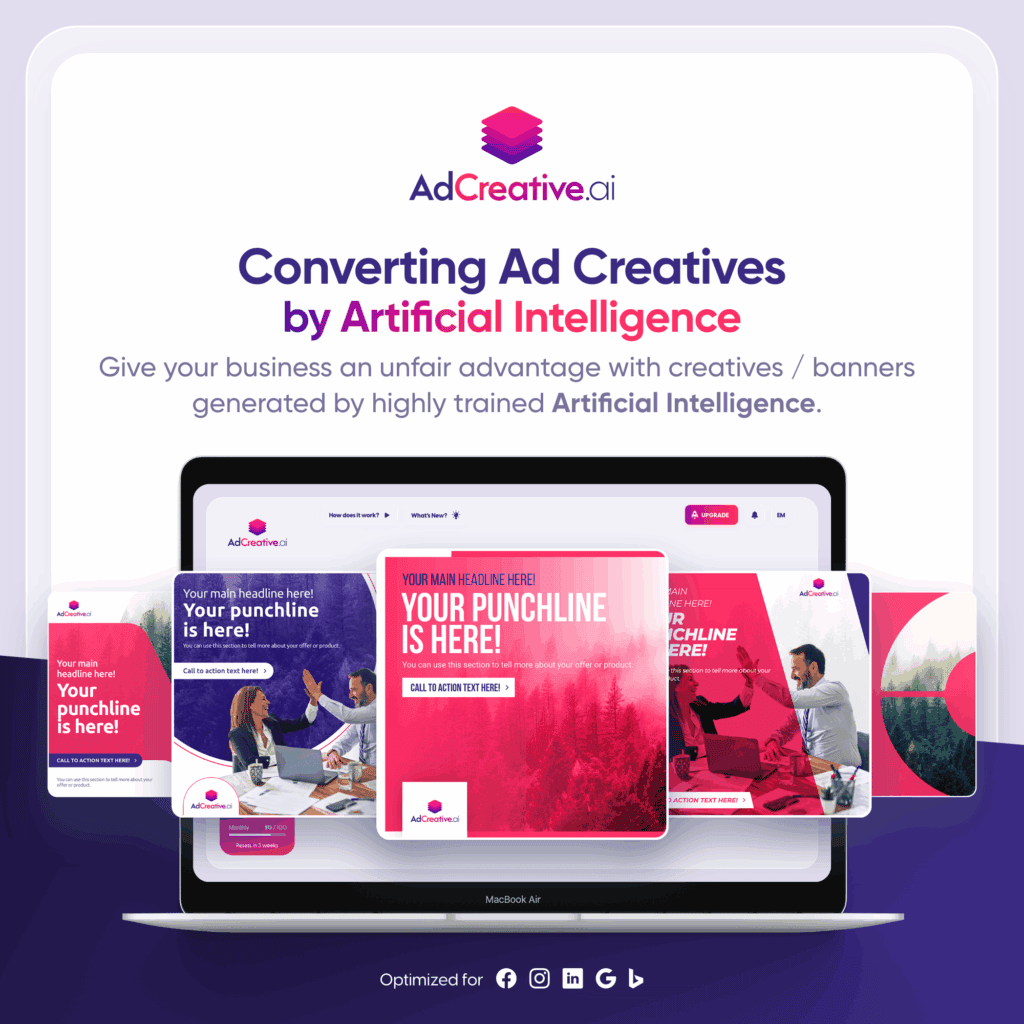The Dos and Don’ts of Ad Placement

Settling on ad placement for your website can be a confusing and overwhelming task. It can be made all the worse by a lack of basic web design experience. But it doesn’t need to hold you back!
We’re going to explain some fundamental principles of how the space is distributed and explain where to position ad content on different web pages.
Advertising performance ultimately depends on effective ad placement. It is a delicate dance that balances ad viewability, user experience, ad size, and your advertising goals. If you can get this right, it should generate a high engagement and click-through rate (CTR).
Understanding Ad Positioning
Before we get stuck into what you should and shouldn’t do for website ad placement, it’s a good idea to first understand how the position of ads works both in terms of engagement and functional real estate.
When it comes to ad positioning, there are two main considerations. What comes above the fold, and what is shown below the fold.
Above the Fold
This is the area of your website that will be first seen by visitors before they begin to scroll. A lot of real estate in this part of your site will be taken up by navigational and branded elements. These can be crucial to how visitors interact with your website.
Above the fold (ATF) is also considered the most expensive area of real estate on your website. This is worth keeping in mind when negotiating with ad networks or for direct ad placement.
This first part of the page receives higher levels of viewership by default because it is what users first see. Many visitors will scroll past this first section almost immediately. In some cases before the page has even fully loaded. For this reason, it is actually the area of around 550 pixels, just above the fold, that gets the highest viewership at 80%.
The issue of loading is also another reason to ensure your ads are displaying as quickly as possible. Be wary that if you are working with ad networks and have sold higher-priced ATF space if your ads don’t load they will receive very little engagement which will lead to poor ad performance and potentially harm your website reputation.
Below the Fold
Once the user begins to scroll down a web page, it is considered to be below the fold. The fold is the imaginary line that has been passed by scrolling. Below the fold (BTF) is where your content needs to shine because it’s the only thing keeping a visitor on the page.
Advertising real estate below the fold is more plentiful than above and therefore isn’t as lucrative. However, there are more opportunities for ad placements. So, provided you don’t clutter the page, you can still expect a reasonable amount of engagement.
According to the study by Josh Schwartz, viewership figures vary below the fold depending on the type of page. Around 50% of readers will see 1500 pixels down the page on content pages and only 1000 pixels on home pages.
To put this into context, most web designers consider 600 pixels down to be the fold line.
If you are using full-page ads that sit in the gutter on either side of a web page, the width fold line is considered to be 1000 pixels. However, full-page ads are generally reserved for e-Commerce sites with extremely high levels of traffic. For sites that are reliant on content, it is best to avoid full-page ads because they are very intrusive to the user experience.
5 Dos and Don’ts for Website Ad Placement
When it comes to ad placement there are many concepts that are based on solid performance data. However, it will always be subjective to different audiences.
These five recommendations are designed to be applicable to just about any business or audience. They utilize free or widely acknowledged data-capturing techniques to provide the most accurate results for each publisher and site owner.
1. Define the Goals of Your Site Advertising
Before deciding what placement will be optimal for your audience, you must first consider your goals for advertising on your site.
Are you looking to maximize reach or maximize exposure time?
If your aim is to maximize the reach of your website advertising, you could be better off placing ad content just above the fold. If you want to maximize the amount of time your visitors will see your website advertising, place it at around 1200px down the page.
It may seem like a strange decision to make, as inevitably the goal of your online advertising is to generate a better CTR rate and increase site revenue. However, the placement of your ad content can be dependent on the content itself, and open up new opportunities for what and how much content you serve in a specific area.
For example, if you need to display larger format ad content that may have more detailed and longer-form messaging, it will perform better and your visitors will have more time to digest it. Equally, you can use the same space to deliver multiple faster-absorbing pieces of ad content. For example, with rotation (by using a Rotating Ad Widget). Because your viewers will inevitably spend more time on this part of the site, it allows you to capitalize on delivering more ad content and hopefully increasing engagement.
The further you move down a page, the safer it is to assume that your visitor is more engaged with your content. This presents more opportunities for advertisements as long as you take care not to disturb their viewing experience. The best solution is to stick to native ads because they are designed to exist within site content.
2. Evaluate Previous Ad Performance
If you are already advertising on your website, you will hopefully have been generating data on how your current ad content is performing.
While the results of industry studies are important to consider, every audience is different and yours might not interact with content in the exact same way. Because of this, having existing data will give you a better understanding of what content is already effective.
You can use this data to help explain why it has been successful and to influence future ad placement.
AdSanity subscribers have two options for generating reporting data. The first—using the Reporting functionality of AdSanity Core—can be accessed from your WordPress dashboard. We have included top ten lists to help you quickly identify top-performing content and you can delve deeper into the statistics for CTR analysis.
We have also expanded your site reporting options to integrate directly with your Google Analytics account. Using the Google Analytics Tracking Add-on, you’re able to offload ad engagement data to your account which also has the added benefit of freeing up space on your site server to improve site performance.
It has a two-fold benefit where your ad content will load faster and you will have even more reporting data to inform future ad placement.
3. Use Ads Sparingly
The old adage “less is more” is particularly important to remember when it comes to website advertising. You have no doubt come across sites in the past that bombard you with advertising. The experience can be borderline offensive.
Ask yourself, is that the type of website you would want to visit again? The chances are the answer is no.
User experience is of paramount importance when it comes to website advertising. If you are not able to keep visitors on your page, then your potential for generating traffic and good click-through rates is doomed to failure.
From an accessibility standpoint, blank space on a website is not a bad thing either. It enables easier navigation and better focus on content.
4. Use the Correct Sized Ads
Different sizes and types of advertisements are better suited to certain visitors and forms of content. Ensuring that you use the correct sized ads for your website layout is key.
Why?
Top-performing ad sizes tend to have a much wider ad inventory when working with an ad network. It also avoids the risk of ads not displaying correctly which can seriously affect your reputation with ad networks. If these are the platforms you are mostly relying on for providing you with ad content, it is best to avoid getting blacklisted.
The Interactive Advertising Bureau (IAB) is the gold standard in advertising standards and you can check their updated list of recommended ad sizes to make sure your available space and ad content sizing are correct.
For AdSanity subscribers, we have created a free and hugely useful Custom Ad Sizes Add-on so that you can customize and save a list of the sizes required for your website to avoid any confusion or misuse of non-standard sizes.
You might also want to check out our latest industry report into what kind of ads make the most money for some inspiration and extra guidance.
5. Website Heatmaps
Following set principles and concepts about optimal ad placement on websites is a worthwhile endeavor, however not all audiences and site visitors are the same. If you have a real niche community, the chances are that they may engage with your content differently.
This is where a website heatmap can be an eye-opener to your user journey.
There are a number of online tools such as Hotjar that allow you to create a website heatmap and see exactly what parts of a webpage are generating the most visitor engagement.
In addition to just telling you where visitors are clicking, it will also show how far down the page visitors are scrolling. This is going to be particularly useful if you create a lot of long-form content and want to include native ads.
Make the Most of Existing Content
Tracking how visitors are interacting with your current advertising content will trump most of the advice you might read on the internet. This is simply because your audience is unique and so is their journey on your website.
We have built a number of powerful add-ons. These extension provide bloggers, publishers, and web developers with a variety of specific tools.
To help you get the most out of AdSanity Add-ons, we have also compiled a helpful guide. We explain where each add-on sits on the advertising scale of publisher to monetization features.
Our goal is to help every business navigate through the complexities of ad placement and ad management. In this way, they can get the most out of their website advertising.
Ready to get started?
There are licenses available for all types of sites needs needs.
Find the AdSanity tier that is right for you.
Want to give AdSanity a try?
Find the plan that fits your site and jump in.
Ready to make your ads work for you?
Pick the plan that fits and get started.
Let’s get your ads running.
Choose the plan that works best for you and start today.
Time to take control of your ads.
Find your perfect plan and go for it.
Ready to Make Money With Your Site?
Get ads on your site in
60 minutes or less
with AdSanity.
With our 14-day money back guarantee, it’s easy to see if AdSanity is the right fit for you.
Tags
Popular Pro Add-Ons
Our Community
Join our mailing list to keep up to date on everything happening with AdSanity and Pixel Jar.
Note: Your email address will be added to our CRM and be used to receive emails from Pixel Jar. You can unsubscribe at any time.



